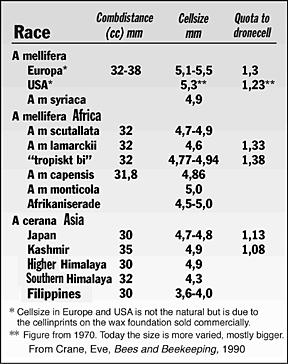It looks like the bee gets to its natural balance on a cell size from 4.9 mm downwards. At 4.9 mm, and the distance between the combs reduced to 32 mm, the temperature in the nest rises, reducing one day of the incubation period. At 20 instead of 21 days, the bees outrun the Varroa.
The Varroa mite is of course aware of that, therefore in the summer it only breeds within the drone brood, as they can’t multiply within the worker brood. The Asian ‘cerana’ and African bees, without varroa problems, build small cells.
here is a map of the cellsizes 100 years ago – click on the map to see it bigger
Observations of Michael Bush
Pre and Post Capping Times and Varroa
8 hours shorter capping time halves the number of Varroa infesting a brood cell.
8 hours shorter post capping time halves the number of offspring of a Varroa in the brood cell.
Accepted days for capping and post-capping, (based on observing bees on 5.4 mm comb)
Capped 9 days after egg laid
Emerges 21 days after egg laid
very important: reducing of comb distance to 32mm
Another point is that small cell bees have a much longer life span, from 8 up to 12 weeks. The conventional large cell bees only have a lifespan of 6 weeks, which is considerably reduced by the use of chemicals, like anti Varroa treatments (Fernando Clatayud, biologist, Valencia, spain). This longer lifespan produces incredibly strong colonies as the work inside of the colony can be done by a lot more bees, which is a prerequisite for a healthy immune system. Ongoing stress by the same amount of work to be done by too few bees negatively affects the bee’s immune system.
Dee Lusby found out that the cellsize of 4.9mm is the actual fundamental prerequisite, that the hygienic behaviour VSH appears, which means the active culling of Varoa mites from the infected brood cells. see hygienic behaviour VSH
With this the topic addressed, there is still much more to be explained. The cell size is only one aspect amongst many that must be changed to get resistant bees.
The history of cell sizes (Dee Lusby)
– The first artificial comb foundation was made in Germany in 1842 by Gottlieb Kretchmer.
– I would say our present era of problems began around 1891 in Belgium with the introduction of artificial comb foundation with 920 cells to the square decimeter which would equate to about midway between 4.6 cm and 4.7cm for 10 worker cells.
 |
| cell sizes of different bee races (in europe and USA too big due to use of too big cellprints) |
A Prof U. Baudoux of Belgium published an article in Progress Apicole in June, 1893, advocating the use of larger comb cells, as a result of experiments duly described. It seems Prof Baudoux wanted to rear bees of extraordinary vigor, able to forage over a more extended flight-radius and to visit a multitude of flowers the nectar of which was, then (and probably still is), out-of-reach of their tongues.
He experimented with cells up to the limit of 750 cells per square decimeter, the sizes of cells which he obtained by stretching wax comb foundation. Then encouraged by his experiences, he wished to do still better—”TO GO TO THE BOUNDS OF POSSIBILITY”. (Here is where our current modern-day problems begin with parasitic mites and their secondary diseases.)
Prof Baudoux experimented with various sizes of foundation per the square decimeter, namely: 750, 740, 730, 710 and down to 675. He also experimented with various ways of measuring cells and devised his own measurement system for it. (Unfortunately, there was no corresponding correlation chart made for his devised measurement system, vs. the traditional way of measuring comb foundation that had been in use for over 2,000 years back to before the time of Christ, so beekeepers could go back and forth between the two measurement systems.)
Prof Baudoux was so successful with his writing and his experiments, and so convincing , that manufacturing houses all started selling foundation with enlarged cells and claiming good results for the use of the same. Most of this work was done around the late 1920s through the 1930s and 1940s. (The result has been that this process of bigger is better with its resultant selling has never stopped, and continues up to modern day to the detriment now, that only enlarged oversized foundations (well beyond the bounds of possibility for bigger honeybees as envisioned by Prof Baudoux) are now only sold and standardized large at that, i.e. 5.7cm for 10 worker cells being about the largest).


